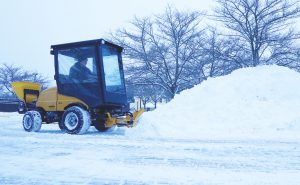A polar vortex swept through Midwest United States the last week of January 2019. This led to Indianapolis having record breaking temperatures of -11 degrees on Jan. 31 and wind chills colder than below 40, according to the National Weather Service. Many K-12 schools and colleges closed, including the University of Indianapolis.
While many students were thrilled about it, the decision to close campus did not come easily. According to Vice President for Student and Campus Affairs Kory Vitangeli, the decision to close involves multiple parties working together to come to a decision. Facilities assess the conditions on campus, while campus police assess the weather and road conditions around Indianapolis.
UIndy facilities’ workers plow snow for the safety of commuting students and vehicles in front of the Christel DeHann Fine Arts Center on Feb. 1, 2018. The snow was a result of the polar vortex that affected the Midwestern US causing dangerously low temperatures that closed campus on Jan. 30 and most of the following morning.
“We are getting feedback from a variety of areas and then we all consult on a conference call, with myself and the president, getting feedback from all of the individuals about various areas of campus,” Vitangeli said. “Then make a decision as to whether we are going to delay, close or operate as normal.”
Event services and athletics are also involved in the decision of closing campus, because they often have events scheduled throughout the week. Prospective students and high schools often visit campus, which they often take into consideration as well. When campus closed due to dangerous temperatures on Wednesday Jan. 30, athletic teams were not allowed to have practice outside at the foresight of the athletic director. Vitangeli said there were not any major events or speakers scheduled for that day, however, School of Psychological Sciences had to have interviews rescheduled and admissions had to reschedule a few campus visits.
Most schools have a set of standards that must be met before closings, such as a low temperature or dangerous road conditions. However, UIndy assesses conditions on a case-by-case basis, according to Vitangeli. Ultimately, the safety of students, faculty and staff is of utmost importance.
“The most important thing that I would take into consideration would be safety,” Executive Vice President and Provost Stephen Kolison said. “The safety of our students, the safety of our faculty and the safety of our staff, that can, especially those who live off campus, [who] can’t make it to campus safely and those who are on campus and unable to get around in a very safe manner.”
Kolison said that he hopes when classes are canceled faculty will work with students to make up for the lost time. He said one of the ways they can do this is through online assignments and work. Even when campus is closed, essential personnel must often remain on campus to accommodate residents. Essential personnel often includes dining staff, campus police and facilities.
“We have to work with food service,” Vitangeli said. “Our food service does not shut down when we do and so I worked with our food service to make sure that they understood that even though we were closing, students were still here, there were going to be a lot of people that still need to eat…and they needed to make sure that they stocked their staff and continued food service.”
It is rare for the university to close, and it is only done when safety is a major concern. Because UIndy is open throughout the winter, faculties must take precautions and measures to prepare campus. Winterizing campus starts long before the winter season. According to Director of Grounds Dusty Bodart, facilities begin to winterize their irrigation system in the fall. All of the water is blown out of the underground pipes to prevent them from freezing and breaking. Ordering ice melt solution and salt is another part of the maintenance routine. About two truckloads of ice melt is ordered in the fall, according to Bodart, which is about 40 palettes. This is within their $20,000 budget, Bodart said.
“The most important thing that I would take into consideration would be safety.”
The initial preparations are only one piece, however, as campus must be maintained throughout the winter. According to Bodart, the facilities team has a plan in place based on what is happening around campus. If it is a holiday or break when dorms and dorm parking lots are closed, those would be lower on the priority list. However, if students are on campus those are the areas where the team starts. Maintenance also has to routinely check the equipment used such as plows and salt spreaders because this season can be hard on the machinery.
The winter season is a constant job for the facilities team. They have to continuously take inventory of their ice melt supplies as well as make sure campus activities run smoothly. There are times when the team of six people, which includes Bodart, work through the night to keep those on campus safe from the winter weather.
“I just want people to understand,” Bodart said, “We don’t just go out in all directions. We do have a plan in place and we are trying to accomplish everything as best fit for the situation.”







